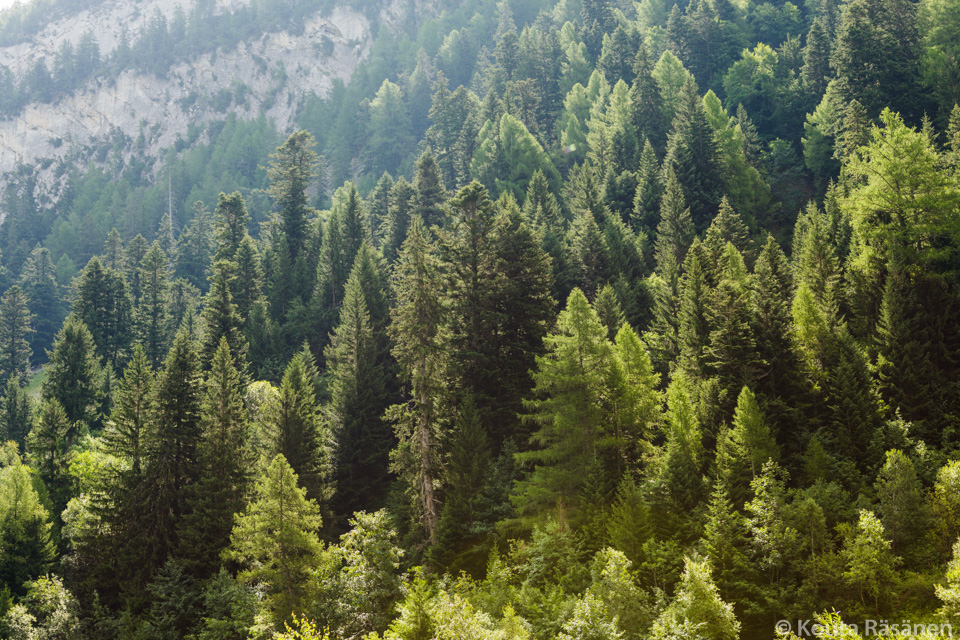
Derborence Nature Reserve, Switzerland
The Derborence Valley is described in literature as dramatic, indomitable and awe-inspiring1. At the valley bottom lies a small lake, Lac de Derborence, which most visitors consider to be the area’s main attraction.
The forest on the steep northwest-facing slope southeast of the lake (photo below) remained virtually untouched, because an earthquake and subsequent landslides in 1714 and 1749 made the valley nearly inaccessible1 2. It was not until 1967 that a road to Derborence was opened1. Already before that, in 1956, the virgin forest was placed under protection. Only 22 hectares of the 52-hectare nature reserve are forest, the rest consisting of avalanche paths and rock1. Furthermore, the northernmost part of the nature reserve east of the lake consists of young forest. The actual primeval forest on the steep slope is considered the most pristine old-growth forest relic in Switzerland1. It is believed that firewood was collected here in the past, and cattle grazed at the lowest elevations of what is now the nature reserve1.

The Derborence Nature Reserve extends from 1430 to over 2000 m above sea level, but does not reach the forest limit. Mean annual temperature is 5–6°C and annual precipitation 1200–1800 mm 3. The bedrock consists almost exclusively of limestone3.
A storm damaged and uprooted many trees in 1990, and after that European spruce bark beetle (Ips typographus) killed plenty of spruce trees1. Nevertheless, there are still tall spruce in Derborence. Due to the wide avalanche paths and damage caused by storms and bark beetles, Derborence does not give the impression of a closed forest area – the forest is relatively open with many gaps. As a result, the undergrowth is lush and diverse. Tree regeneration is plentiful, too. The amount of deadwood is very high.
The most common tree species are European silver fir (Abies alba), Norway spruce, European larch (Larix decidua, especially on the upper slope) and Swiss mountain pine (Pinus uncinata, especially on rock faces). In the numerous gaps, there is an abundance of sycamore maple (Acer pseudoplatanus), European rowan (Sorbus aucuparia) and green alder (Alnus viridis). The other tree and tall shrub species are Scots pine (Pinus sylvestris), arolla pine (Pinus cembra), silver birch (Betula pendula), large-leaved willow (Salix appendiculata), European beech (Fagus sylvatica), whitebeam (Sorbus aria, syn. Aria edulis) and alpine laburnum (Laburnum alpinum). Thus, the diversity of conifer species is quite high at 7 species, if the shrub-like common juniper (Juniperus communis) is included. On rock faces, Swiss mountain pine grows in a shrub-like form, too (photo right). In contrast to many other forest areas in the Alps, silver fir can regenerate here without all the seedlings being browsed.
At the bottom of the slope there are several thick fir trees with diameters of up to 148.5 cm 1. The tallest measured fir is 42 m tall 4. The oldest fir trees have been standing here for over three centuries5 . The forest is the subject of intensive research and has marked study plots.

The Derborence Valley can be reached by bus or car. North of the lake there is an alpine hut called “Refuge du Lac de Derborence” with a restaurant and accommodation. A marked hiking trail runs around the lake. Almost all visitors hike this trail at most or simply stay at the hut and go to the lake shore. However, the marked trail does not reach the actual virgin forest. There is a little-used narrow path through the entire nature reserve, marked on maps but not on site. It starts at the westernmost avalanche path, runs through the primeval forest and leaves the nature reserve at approx. 1830 m. The vista from the upper slope is magnificent but the reserve is small and close to the infrastructure around the lake, which can be heard and seen from the entire reserve.
KR
References:
- Heiri, C. et al. (2011): Windwurf und Wiederbewaldung im Urwald von Derborence. In Brang, P., Heiri, C. & Bugmann, H.: Waldreservate: 50 Jahre natürliche Waldentwicklung in der Schweiz. Haupt.
- Idoate-Lacasia, J. et al. (2024): Long-term biomass dynamics of temperate forests in Europe after cessation of management. Forest Ecology and Management 554.
- Droz, J. (1994): La végétation da la région de Derborence (Conthey, Chamoson, Valais). Geobot. Helv. 70.
- https://www.monumentaltrees.com/en/che/vallese/conthey/16709_reservenaturelledederborence/31596/
- https://www.pronatura.ch/de/naturschutzgebiet-derborence#